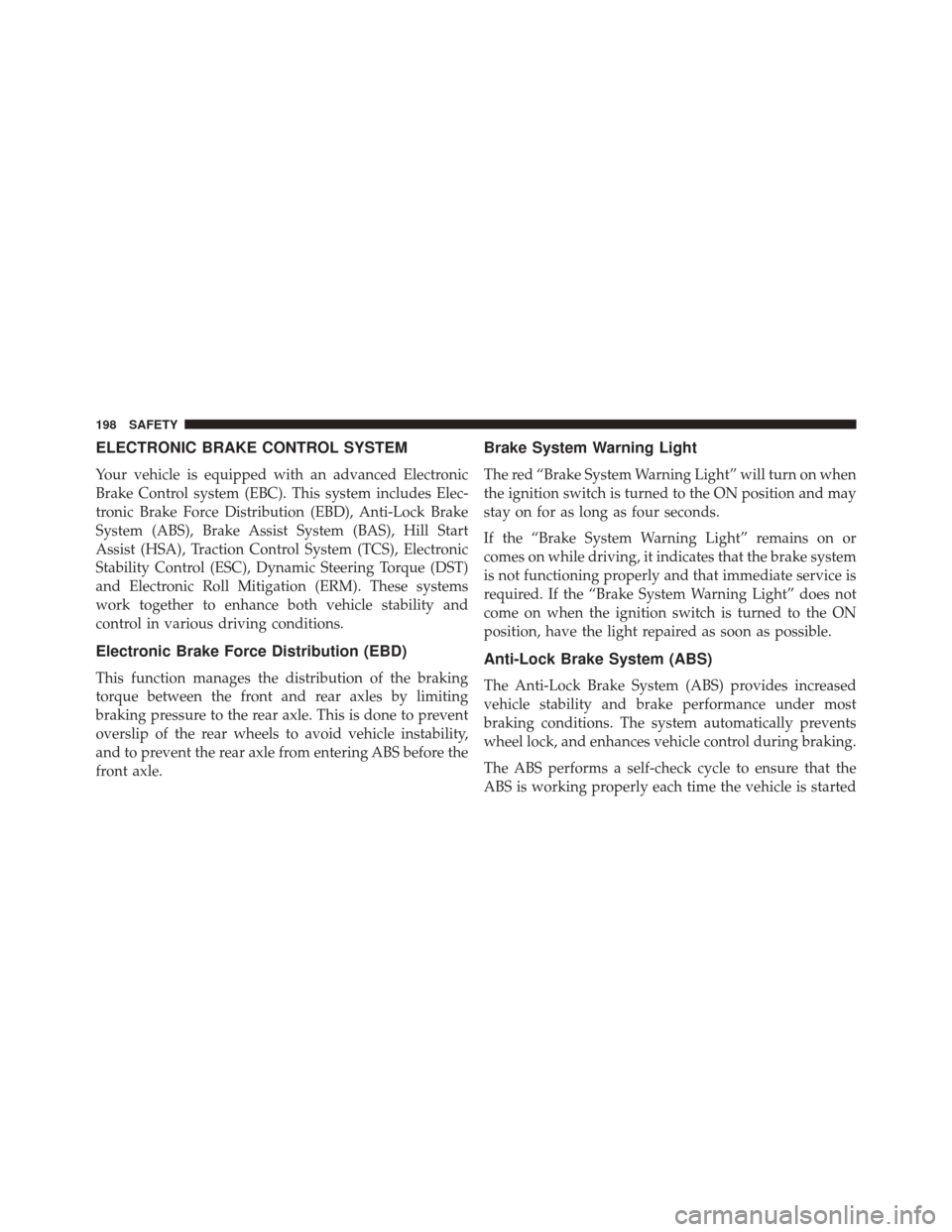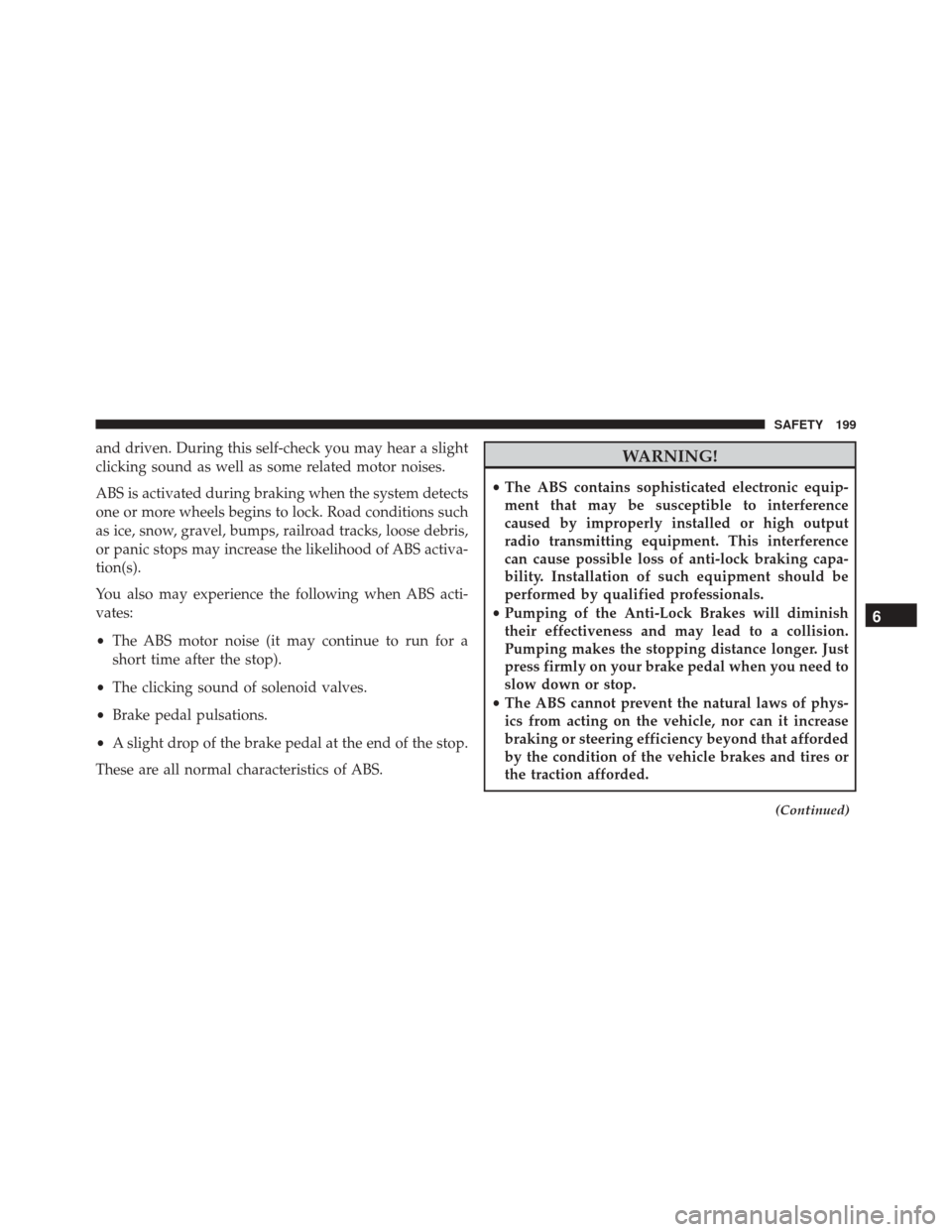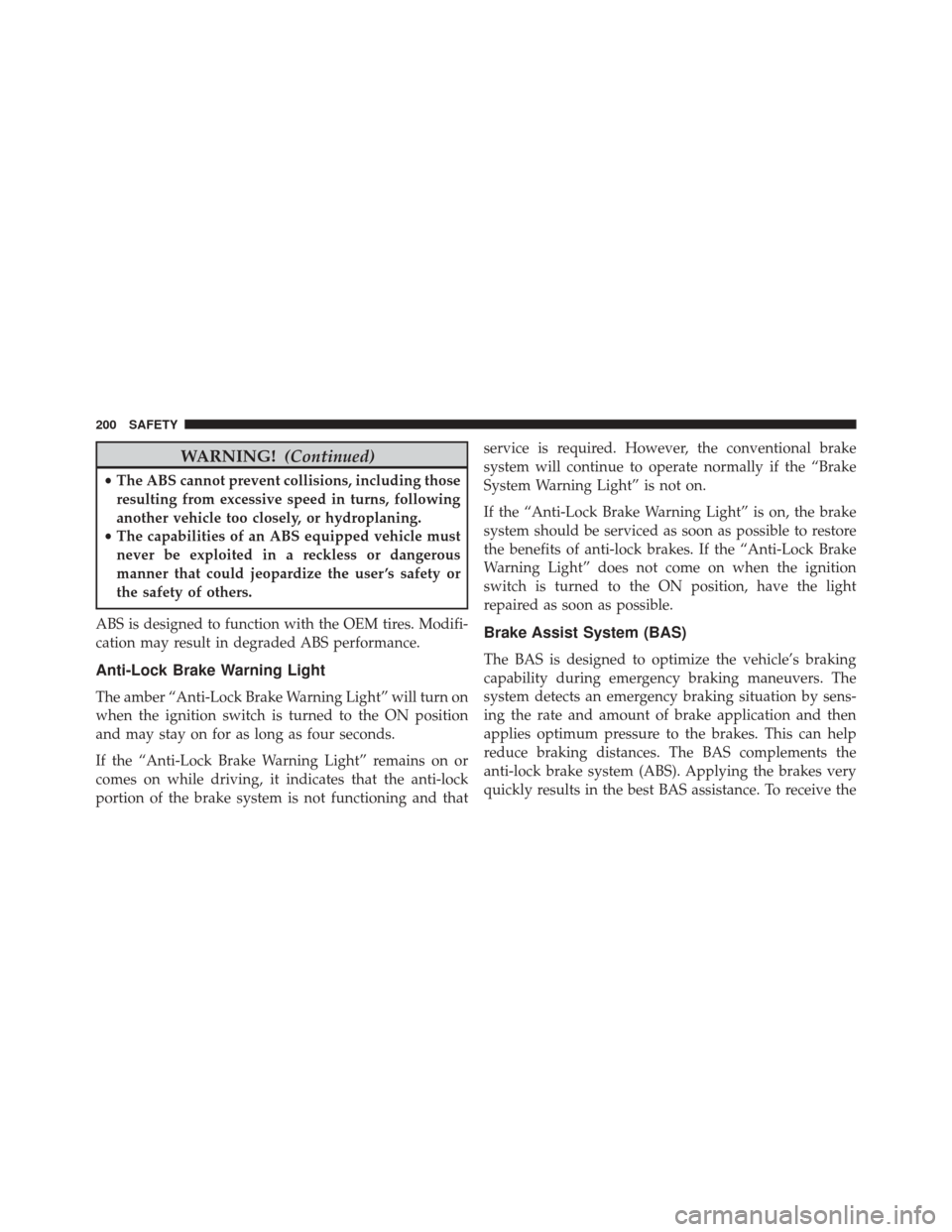Page 189 of 587
(if at idle). If the charging system light remains on, it
means that the vehicle is experiencing a problem with
the charging system.
•What To Do
Have your vehicle serviced immediately. See an au-
thorized dealer.
Door Ajar •What Does It Mean
This light will illuminate to indicate that
one or more doors may be ajar. With the
doors open and the vehicle in motion, a
chime will sound.
What To Do
Properly close the door(s). Hood Open Warning Light
•What Does It Mean
The light will illuminate when the engine
hood is not completely closed. With the
hood open and the vehicle in motion, a
chime will sound.
• What To Do
Properly close the hood.
Liftgate Open Warning Light •What Does It Mean
This light will illuminate when the liftgate
is open. With the tailgate open and the
vehicle in motion, a chime will sound.
• What To Do
Properly close the liftgate.
5
GETTING TO KNOW YOUR INSTRUMENT CLUSTER 187
Page 190 of 587

Electronic Throttle Control (ETC)•What Does It Mean
The light will illuminate when the ignition
is first placed in the MAR/RUN or AVV/
START position and remain on briefly as a
bulb check. If the light does not come on during
starting, have the system checked by an authorized
dealer.
If a problem is detected, the light will come on while
the engine is running. Bring the vehicle to a complete
stop and place it into PARK. Cycle the ignition to the
STOP/OFF position; the light should turn off.
If the light remains lit with the engine running, your
vehicle will usually be drivable. However, see an
authorized dealer for service as soon as possible.
If the light is flashing when the engine is running,
immediate service is required. You may experience reduced performance, an elevated/rough idle or en-
gine stall, and your vehicle may require towing.
Automatic Transmission Failure •What Does It Mean
This light will illuminate when the system
detects a failure of the automatic transmis-
sion.
• What To Do
Contact an authorized dealer as soon as possible.
Oil Temperature Warning Light •What Does It Mean
This light indicates engine oil temperature
is high.
188 GETTING TO KNOW YOUR INSTRUMENT CLUSTER
Page 195 of 587
Power Steering System Warning•What Does It Mean
This light will illuminate to indicate a fail-
ure in the Electronic Power Steering System
(EPS). Although it will still be possible to
steer the car, additional effort may be needed to
operate the steering wheel.
• What To Do
Please contact an authorized dealer as soon as pos-
sible.
5
GETTING TO KNOW YOUR INSTRUMENT CLUSTER 193
Page 197 of 587
SAFETY
CONTENTS
�BRAKE SYSTEM ...................... .197
� ELECTRONIC BRAKE CONTROL SYSTEM . . . .198
▫ Electronic Brake Force Distribution (EBD) . . . .198
▫ Brake System Warning Light ..............198
▫ Anti-Lock Brake System (ABS) ............198
▫ Anti-Lock Brake Warning Light ............200
▫ Brake Assist System (BAS) ...............200
▫ Hill Start Assist (HSA) .................201
▫ Traction Control System (TCS) ............203
▫ Electronic Stability Control (ESC) ..........204▫
Electronic Roll Mitigation (ERM) ..........205
▫ Dynamic Steering Torque (DST) ...........206
� OCCUPANT RESTRAINT SYSTEMS .........207
▫ Important Safety Precautions .............207
▫ Seat Belt Systems .....................209
▫ Supplemental Restraint System (SRS) .......224
▫ Child Restraints ..................... .241
▫ Transporting Pets .....................262
� SAFETY TIPS ........................ .262
▫ Transporting Passengers .................262
6
Page 199 of 587

BRAKE SYSTEM
Your vehicle is equipped with dual hydraulic
brake systems. If either of the two hydraulic
systems loses normal capability, the remaining
system will still function. However, there will
be some loss of overall braking effectiveness. This will be
evident by increased pedal travel during application and
greater pedal force required to slow or stop the vehicle. In
addition, if the malfunction is caused by a leak in the
hydraulic system, the “Brake Warning Light” will turn on
as the brake fluid level drops in the master cylinder.
In the event power assist is lost for any reason (i.e.,
repeated brake applications with the engine OFF) the
brakes will still function. However, the effort required to
brake the vehicle will be much greater than that required
with the power system operating.
WARNING!
• Riding the brakes can lead to brake failure and
possibly a collision. Driving with your foot resting
or riding on the brake pedal can result in abnor-
mally high brake temperatures, excessive lining
wear, and possible brake damage. You would not
have your full braking capacity in an emergency.
• Driving a vehicle with the “Brake Warning Light”
on is dangerous. A significant decrease in braking
performance or vehicle stability during braking
may occur. It will take you longer to stop the
vehicle or will make your vehicle harder to control.
You could have a collision. Have the vehicle
checked immediately.
6
SAFETY 197
Page 200 of 587

ELECTRONIC BRAKE CONTROL SYSTEM
Your vehicle is equipped with an advanced Electronic
Brake Control system (EBC). This system includes Elec-
tronic Brake Force Distribution (EBD), Anti-Lock Brake
System (ABS), Brake Assist System (BAS), Hill Start
Assist (HSA), Traction Control System (TCS), Electronic
Stability Control (ESC), Dynamic Steering Torque (DST)
and Electronic Roll Mitigation (ERM). These systems
work together to enhance both vehicle stability and
control in various driving conditions.
Electronic Brake Force Distribution (EBD)
This function manages the distribution of the braking
torque between the front and rear axles by limiting
braking pressure to the rear axle. This is done to prevent
overslip of the rear wheels to avoid vehicle instability,
and to prevent the rear axle from entering ABS before the
front axle.
Brake System Warning Light
The red “Brake System Warning Light” will turn on when
the ignition switch is turned to the ON position and may
stay on for as long as four seconds.
If the “Brake System Warning Light” remains on or
comes on while driving, it indicates that the brake system
is not functioning properly and that immediate service is
required. If the “Brake System Warning Light” does not
come on when the ignition switch is turned to the ON
position, have the light repaired as soon as possible.
Anti-Lock Brake System (ABS)
The Anti-Lock Brake System (ABS) provides increased
vehicle stability and brake performance under most
braking conditions. The system automatically prevents
wheel lock, and enhances vehicle control during braking.
The ABS performs a self-check cycle to ensure that the
ABS is working properly each time the vehicle is started
198 SAFETY
Page 201 of 587

and driven. During this self-check you may hear a slight
clicking sound as well as some related motor noises.
ABS is activated during braking when the system detects
one or more wheels begins to lock. Road conditions such
as ice, snow, gravel, bumps, railroad tracks, loose debris,
or panic stops may increase the likelihood of ABS activa-
tion(s).
You also may experience the following when ABS acti-
vates:
•The ABS motor noise (it may continue to run for a
short time after the stop).
• The clicking sound of solenoid valves.
• Brake pedal pulsations.
• A slight drop of the brake pedal at the end of the stop.
These are all normal characteristics of ABS.WARNING!
• The ABS contains sophisticated electronic equip-
ment that may be susceptible to interference
caused by improperly installed or high output
radio transmitting equipment. This interference
can cause possible loss of anti-lock braking capa-
bility. Installation of such equipment should be
performed by qualified professionals.
• Pumping of the Anti-Lock Brakes will diminish
their effectiveness and may lead to a collision.
Pumping makes the stopping distance longer. Just
press firmly on your brake pedal when you need to
slow down or stop.
• The ABS cannot prevent the natural laws of phys-
ics from acting on the vehicle, nor can it increase
braking or steering efficiency beyond that afforded
by the condition of the vehicle brakes and tires or
the traction afforded.
(Continued)
6
SAFETY 199
Page 202 of 587

WARNING!(Continued)
•The ABS cannot prevent collisions, including those
resulting from excessive speed in turns, following
another vehicle too closely, or hydroplaning.
• The capabilities of an ABS equipped vehicle must
never be exploited in a reckless or dangerous
manner that could jeopardize the user ’s safety or
the safety of others.
ABS is designed to function with the OEM tires. Modifi-
cation may result in degraded ABS performance.
Anti-Lock Brake Warning Light
The amber “Anti-Lock Brake Warning Light” will turn on
when the ignition switch is turned to the ON position
and may stay on for as long as four seconds.
If the “Anti-Lock Brake Warning Light” remains on or
comes on while driving, it indicates that the anti-lock
portion of the brake system is not functioning and that service is required. However, the conventional brake
system will continue to operate normally if the “Brake
System Warning Light” is not on.
If the “Anti-Lock Brake Warning Light” is on, the brake
system should be serviced as soon as possible to restore
the benefits of anti-lock brakes. If the “Anti-Lock Brake
Warning Light” does not come on when the ignition
switch is turned to the ON position, have the light
repaired as soon as possible.
Brake Assist System (BAS)
The BAS is designed to optimize the vehicle’s braking
capability during emergency braking maneuvers. The
system detects an emergency braking situation by sens-
ing the rate and amount of brake application and then
applies optimum pressure to the brakes. This can help
reduce braking distances. The BAS complements the
anti-lock brake system (ABS). Applying the brakes very
quickly results in the best BAS assistance. To receive the
200 SAFETY